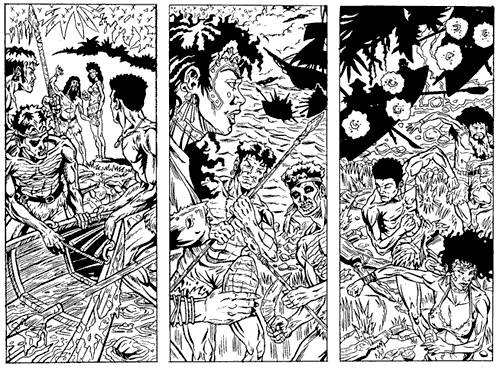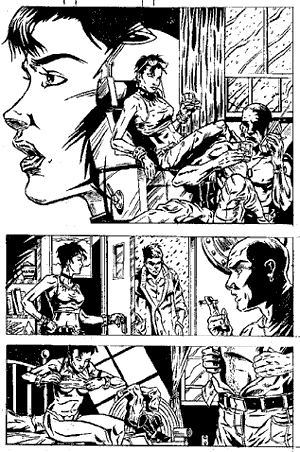|
|
|
|
| ||||||||||||||||||||||||
|
Become a Patron! |
Art tips and techniques, reviews and interviews from my studio. Archived here and at World Famous Comics. Comics 101 for 08/14/2003 THE IMPORTANT ELEMENTS OF STORYTELLING - Part 1 Comic books, like movies, are an inheritly powerful medium visually. Which is why often, when handled properly, certain films translate well into comic books (Star Wars, Aliens, The Matrix) and certain comic books look great on film (Tim Burton's Batman films or the animated series, The Crow, Blade). As a comic book penciler, it's best to think of yourself as a director and the comic book you are drawing as your film, wherein you are controlling the visuals, pacing of the story, and movement of the camera from panel to panel and page to page. Just as there are certain rules a director follows to make a good movie, there are rules a penciler follows to draw a good story. Let me start off by saying that I'm one for never adhering to rules too strictly. I often think rules are meant to be bent or broken in dealing with art. If artists didn't ever break rules, we would never experience the unique and influential styles of many artists over the centuries that have influenced a popular culture medium like comic books. But before rules can be broken, we must first come to grips with what these rules are and understand them. In comic books, more specifically the penciling aspect of them, there are essential rules that always apply and are followed for storytelling in that medium. These rules were passed on to me by my friend and former teacher, Darryl Banks, as his student while taking the the Comic Book-Cartoon Illustration class at the Columbus College of Art and Design. I'll be expanding upon these rules and passing them on to you here in hopes of helping you better realize your storytelling skills as a comic book penciler. Some of these rules may seem obvious and others overstated, but unless you comprehend these basic rules, you won't be able to create your unique, visual, artistic style by being able to bend or break them. 1) Action/Motion is Always Occurring Left to Right We have been taught all our lives to read and write from left to right. We should also learn as pencilers not only do we compose our panels and page layouts in a sensible left to right, top to bottom format, but we should compose our designs and action in those panels and pages with the same mindset as well. Moving the characters and action in a left to right direction in your panels propels the reader to the next panel and then the next page. In this example we follow the Aborigine warriors pulling their boat onto shore from the bottom left of the panel to the upper right. In panel two the dominant female figure in the foreground is leading us into the panel from the left side and looking at the sub-dominant figures to the right of herself. In panel three the silohuetted bad guys in the canoes are shooting at the fleeing warriors towards the bottom right. The entire design movement from the first panel to the third propels the story logically and comfortably from the left to the right and finally carries us off the page.  2) Be Aware of Consistency and Continuity Characters, objects, and places should look recognizable and be consistent from panel to panel, even as angles and views vary. This will allow your readers to identify with the characters and not lose focus of the story or be confused when moving throughout the pages or panels. In panel one the dominant portrait of the female figure is recounting herself and other characters in an earlier scene. Ironically, I had to draw to this same character twice in one panel (which in essence, is really two panels since it's working as a flashback montage here) and I had to make sure I drew her likeness that much more accurate and identifiable to prevent confusion. Even though as angles and scenery changes in the following two panels, I keep the female figure recognizable not only by accurately keeping her features consistent, but also by using another technique. By drawing her the same general size in these series of panels, it provides an extra consistency to the character and lends to the authenticity of her likeness from scene to scene. I chose to use this technique since these scenes are a series of flashbacks.  See ya back here next week for more important elements! -Joe Recent Columns:
© 2024 - , 153 Sheffield Way, Sandusky, OH 44870 All other ® & © belong to their respective owners. | ||||||||||||||||||||||||